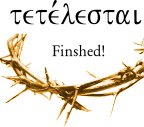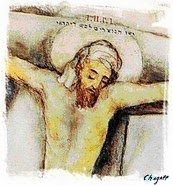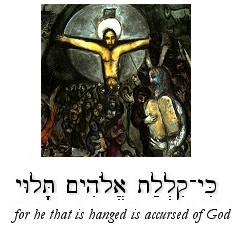|
Our Torah portion for this week (i.e., Ki Teitzei) includes the statement that a man who was to be executed and "hanged on a tree" (עַל־עֵץ) was under the curse of God, that is, was utterly condemned under the verdict of the law (Deut. 21:22-23). According to the Talmud (Nezakim: Sanhedrin 6:4:3), the Great Sanhedrin (סַנְהֶדְרִין גְדוֹלָה) decided that "a man must be hanged with his face towards the spectators" upon a wooden stake, with his arms slung over a horizontal beam. It should be noted that while this is technically not the same thing as the gruesome practice of Roman crucifixion, the reasoning based on this verse was apparently used to justify the execution of Yeshua (Mark 15:9-15; John 19:5-7; 15). The exposed body was required to be buried before sundown to keep the land from being defiled. Besides the shame of this manner of death, the one so executed would be unable to fall to their knees as a final act of repentance before God, thereby implying that they were under the irrevocable curse of God (קִלְלַת אֱלהִים).
In this connection, we should note that Yeshua was falsely charged with blasphemy before the corrupt Sanhedrin of His day (Matt. 26:65; Mark 14:64; John 10:33) - an offence that was punishable by stoning (Lev. 24:11-16). However, since the Imperial Roman government then exercised legal hegemony over the region of Palestine, all capital cases were required to be submitted to the Roman proconsul for adjudication, and therefore we understand why the Jewish court remanded Yeshua and brought him to be interrogated by Pontius Pilate. Because Roman law was indifferent to cases concerning Jewish religious practices (i.e., charges of blasphemy), however, the priests further slandered Yeshua by illegitimately switching the original charge of blasphemy to that of sedition against Rome. The Sanhedrin undoubtedly rationalized their duplicity because the Torah allowed for an offender to impaled or "hung on a tree" (Num. 25:4), and since they were unable to do carry out this judgment because of Roman rule in the area, they needed Pilate to condemn him to death by crucifixion (Matt. 27:31; Mark 15:13-4; Luke 23:21; John 19:6,15). Note that crucifixion is mentioned elsewhere in the Talmud (Nashim: Yevamot 120b) regarding whether a widow can remarry if her husband had been crucified, as well as by the Jewish historian Josephus. The Talmud furthermore alludes to the death of Yeshua where Yeshua is said to have been crucified on "eve of Passover" (Nezekin: Sanhedrin 43a).
Now some people say that the word "cross" in the New Testament should rather be translated as "stake" or "tree" instead, claiming that the shape of the instrument that Yeshua was crucified upon was not cross-shaped or "cruciform." Now while the Greek word translated "cross" (i.e., σταυρός) is not fully described in the New Testament, according to ancient historians there were different "shapes" of the means used for crucifixion, including the crux simplex (|), the crux immissa (+), the crux commissa (T), and even stakes shaped as an X or Y. The "T" shape (commissa) was described by the historian Josephus, and is likely the form used to crucify Yeshua, since the early Christians all referred to it that way. There are also ancient Greek (pre-Christian era) descriptions of crucifixion. For example Herodotus (450 BCE) wrote: "they crucified him hands and feet stretched out and nailed to cross-pieces," which suggests that the cross immissa or commisa shape was used in ancient times... Incidentally the gruesome practice of crucifixion goes back to the ancient Persians and Phoenicians.
So it is likely that Yeshua was crucified on a stake made of a cedar tree that was formed by attaching a crossbeam to a pole that was inserted into the ground. It is also likely that he carried only the crossbeam, or gibbet, as he walked to Golgotha to be hung up to die, since the stake would likely have weighed 300 pounds or so, and after brutal flogging under Roman whips it is unlikely that even the strongest of men could carry one... Moreover, the description of a Roman soldier putting a sponge on a hyssop stalk to give Yeshua a drink suggests that he was crucified on "short cross," since the stalk was usually less than two feet long. Regardless of the exact shape of the cross, however, death by crucifixion was horrifyingly shameful and unutterably painful.... but Yeshua went there for you.
וְהוּא מְחלָל מִפְּשָׁעֵנוּ מְדֻכָּא מֵעֲוֹנתֵינוּ
מוּסַר שְׁלוֹמֵנוּ עָלָיו וּבַחֲבֻרָתוֹ נִרְפָּא־לָנוּ
ve·hoo mei·choh·lal mee-pe'·shah·ei'·noo mei·doo·ka me·a·voh·noh·tey'·noo
moo·sahr she·loh·mei'·noo ah·lav oo·va·cha·voo·ra·toh neer·pah- lah'·noo

"But he was pierced for our transgressions, he was crushed for our iniquities,
the correction of our peace was upon him, and by his wound we are healed"
(Isa. 53:5)
 |
The Torah clearly teaches there is no remission of sin without the shedding of blood (Lev. 17:11, Heb. 9:22). The sacrificial death of Yeshua as the great "Lamb of God" was intended not only to cleanse us from sin (and to absolve us from the verdict of guilt as required by the law), but was also intended to fully satisfy both God's justice and and compassion (see Rom. 3:22-25; Psalm 85:10). In other words the cross is the place (ha'makom) where Yeshua "became sin for us" - the One who knew no sin - that we might be made the righteousness of God (2 Cor. 5:21). As the apostle Paul wrote: "The Messiah redeemed us from the curse of the law by becoming a curse for us -- for it is written, 'A Man hanged on a tree is cursed...' (Gal. 6:13, quoting Deut. 21:22-23). The Son of Man was "lifted up" to save from death as the brazen serpent (נְחַשׁ נְחֹשֶׁת) in the desert prefigured (Num. 21:9; John 3:14-15). And just before Yeshua died upon the cross, he said something of tremendous significance. Eyewitnesses to his crucifixion wrote, "When he had received the drink (of vinegar) Yeshua said, 'It is finished.' With that, he bowed his head and gave up his spirit" (John 19:30; Matt. 27:50). In Koine Greek, this final statement is recorded as a single word: tetelestai (Τετέλεσται), a cheer of victory and triumph. In Hebrew, Yeshua might have uttered, "nishlam" (נִשְׁלָם) or perhaps more likely "gemar tov" (גְמָר טוּב), testifying to his fully accomplished atonement (כַּפָּרָה) made on our behalf....

In Greek, the word tetelestai (Τετέλεσται) is an "indicative perfect passive" form of the verb teleo (τελέω) which implies that something has been completed with an enduring effect or state. The verb comes from telos (τέλος), a noun meaning a goal or purpose. Telos is the word Paul used when he wrote: "For Messiah is the end of the law (τέλος νόμου) for righteousness to everyone who believes" (Rom 10:4).
Tetelestai was the cry of victory to the Father. "I have finished the work you gave me to do." What was that work? To establish the new covenant (brit chadashah) between God and man by offering up His life as the atoning sacrifice for humanity's sins (Heb. 1:3, 10:12). The priesthood of Yeshua is said to be after the "order of Malki-Tzedek," based on a direct oath from God, that predates the operation of the Levitical priesthood (for more information about the role of Yeshua as our High Priest, see the article "Yom Kippur and the Gospel"). Yeshua was the only Tzaddik who ever completely walked out the truth of Torah. He expressed its inner meaning perfectly and embodied its truth in full. The Akedah of Yeshua (i.e., His crucifixion at Moriah) was the altar where the justice and chesed (love) of the Father fully met. If God were not just, Yeshua did not need to die; and if God were not loving, He would not have given up His Son as a ransom for our sin. Justice and mercy kiss.
The Torah (i.e., law) is holy, just and good (Rom. 7:12), but those seeking righteousness based on it's demands will discover the tragic fact that it is powerless to impart righteousness and life (2 Cor. 3:7-18). It is sin within the human heart that condemns people - not the law! The crucifixion of Yeshua condemned sin in the flesh (again, not the law) and now the righteousness of God is imparted to those who embrace Yeshua by faith (Rom. 8:3-4). Enabled by the Holy Spirit, with the law now written upon our hearts (Jer. 31:31-3; Heb. 8:10-11), we are empowered to fulfill the requirements of the law based on a new covenant relationship with God (Gal. 2:16, 3:2). We no longer seek righteousness by means of maintaining ritualistic or other ordinances (Rom. 4:5, Gal. 2:16) but by receiving the free gift of Messiah's righteousness imputed to us through our trust (Eph. 2:8-9). Because of Yeshua's victory, we do not strive for acceptance before the Father, we abide within it, chaverim (John 15:4).
Imagine for a moment what it might have been like to hear Yeshua cry out, "It is finished!" His final breath, His kiddush Hashem, His spirit given up and now released before the Father - the resonance of this word filling all heaven and all earth - "It is finished! Father! It is finished! I have completed the work that you have given me to do!" Imagine the joy, the celebration, the glory, the honor given to the Son as He appeared before the Father after securing us so great a salvation.
Because Yeshua became our "serpent" upon the cross, all those who have been bitten by snake and poisoned by the venom of sin may be delivered. Just as the image made in the likeness of the destroying snake was lifted up for Israel's healing, so the One made in the likeness of sinful flesh (Rom. 8:3) was to be lifted up as the Healer of the world. Likewise with the other pictures of our Savior as the "leper Messiah," as the "red heifer" who purifies from death, as the "scapegoat" sacrifice who sends our sins into exile, and so on. Yeshua is Adonai Tzidkenu - the LORD our Righteousness. Blessed be His Name forever and ever...
Note: For more on this see: "The Offense of the Cross: Reflections on Skandalon."
|





